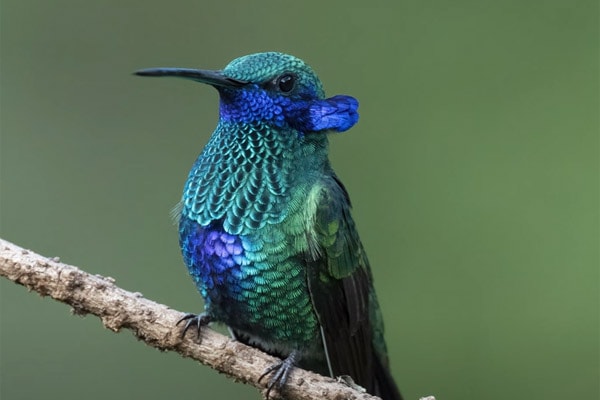Contents
- Sparkling violetear facts
- How to Identify A Sparkling violetear
- Where You’ll See a Sparkling violetear
- Diet and Feeding Preferences of the Sparkling violetear
- Sparkling violetear Nesting
- Sparkling violetear Behavior
- Conservation Status of the Sparkling violetear
- Fun & Interesting Facts about the Sparkling violetear
- Explore More Species in This Family
The Sparkling violetear is a Hummingbird that goes by the scientific name of Colibri coruscans. This captivating bird is predominantly found throughout parts of South and Central America. It has beautiful vibrant and distinctive colors, lots of unique personality quirks and characteristics, and it’s an enchanting and fascinating bird to see.
The thing that many people find most appealing about the Sparkling Violetear is its gorgeous iridescent plumage. The bird’s upper parts show off a beautiful display of vibrant green, while it exhibits a mix of blue and green on its underparts, which creates a stunning shimmering effect that looks amazing depending on how the light hits it in different conditions. Plus, the bird also has a beautiful violet-colored throat, which is the reason why it has its name.
As far as size is concerned, the Sparkling violetear is considered a medium-sized Hummingbird, which is interesting and definitely on the larger side when compared to some of the other birds. Its total body length ranges between 4.3-5.1 inches in length. Even though it has a fairly small stature when compared to many other birds, not just hummingbirds, it still has a decent wingspan of 5.6-6.3 inches.
The great thing about these hummingbirds is they can fly quickly and they are quite agile. They can hover effortlessly by making rapid wing beats, and when it comes time to drink delicious nectar, they’ll have no trouble darting from one flower to the next. Nectar makes up a huge part of their diet, but they also like to consume protein in the form of spiders and small insects.
Right now, I’d like to tell you more about the Sparkling violetear Hummingbird in greater detail. The topics that I’ll flesh out more below include:
- Traits and physical characteristics of the sparkling violetear
- The critical differences between male and female sparkling violetears
- Feeding preferences, dietary choices, nesting patterns, and migration habits of sparkling violetears
- Other pertinent details regarding sparkling violetears
Are you excited to learn more about sparkling violetears? To discover the truth about these beautiful iridescent hummingbirds, please keep reading below to learn much more about these medium-sized speed demons.
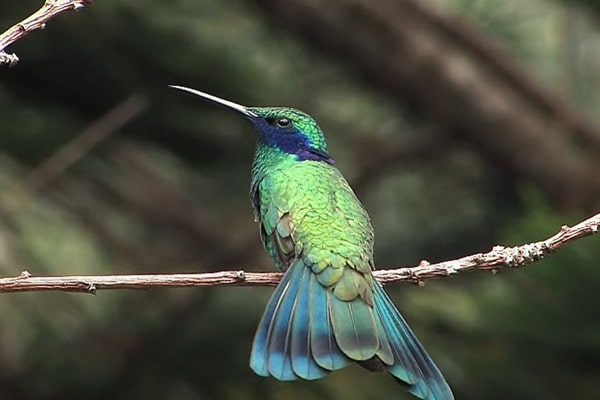
Sparkling violetear facts
- Common Name: Sparkling Violetear
- Scientific Name: Colibri coruscans
- Scientific Family: Trochilidae
- Life Span: 5-6 years
- Size: 4.3 to 5.1 inches
- Wingspan: 5.5 to 6.3 inches
- Weight: 0.25 to 0.35 oz
- Conservation status: Least Concern
How to Identify A Sparkling violetear
For those attempting to identify the sparkling violetear on your next birdwatching trip to Central or South America, there are specific key features that you should look for when identifying this Hummingbird. They include the following:
- Size and Shape – this is a medium-sized Hummingbird, so it roughly measures 4.3-5.1 inches in total length. Another way to measure it is 11-13 cm. Its bill is relatively short and straight and its body is streamlined and compact.
- Plumage – the sparkling violetear upperparts are mostly made up of vibrant green colors, while underneath the underparts the tones are blue and green. Its most distinctive feature of all is its vibrant violet throat patch. Its head and face are also mostly green.
- Iridescent Colors – the beautiful thing about the plumage of the sparkling violetear is that it showcases so many beautiful iridescent colors. This means that the plumage will appear to look different depending on the lighting conditions and the particular angle that you view it from. The green and blue feathers of this bird may shine or shimmer, which often looks like coppery hues, turquoise, or emerald colors.
- Tail – this bird has a relatively long tail. While perched, the tale will extend well beyond the wingtips. The end of the tale is slightly forked and has rounded tips.
Difference between a Male & Female Sparkling violetear
There are differences between male and female sparkling violetears, which is known as sexual dimorphism. The plumage isn’t very different between the two because both males and females tend to have green upperparts and blue-green underparts. The main difference is the throat patch. The females do not have the vibrant violet throat patch which gives this bird its name.
The crown is another noticeable difference between males and females. The male crown tends to look dark green. It has a darker shade of green on the crown and the rest of the body. Females, on the other hand, have a green crown, but it isn’t dark green, and it tends to blend in with the rest of their body.
The tailfeathers are also different for males and females of the species. The males have deeply forked tail feathers and elongated outer feathers that extend out much further than the rest of the tail. Females have a tale that is a lot less deeply forked when compared to males, and the outer tail feathers are short by comparison. Female tail feathers are usually a mixture of green and black, while male tail feathers are black or dark colored, so that’s a little different as well.
Differences in Summer Plumage vs Winter Plumage
Sparkling violetears do not undergo seasonal changes when it comes to their plumage, which is different from other bird species. Their plumage tends to remain consistent all year long, and this is true of both males and females who maintain their traditional patterns and colors throughout the year.
Where You’ll See a Sparkling violetear
Unlike other hummingbirds that you might see at your feeder, the sparkling violetear Hummingbird loves to spend its days and nights in diverse forested areas. In particular, it lives in Central and South America in areas with dense vegetation, or cloud or montane forests. They also have no problem living in areas with lots of flowering plants, so you may find them in parks, gardens, or other urban areas as long as nectar is around in plentiful supply.
You can find these birds in various countries. They include the following:
- Mexico – these hummingbirds are found in certain parts of Mexico. In particular, they tend to stick to the southern and central regions.
- Central America – sparkling violetear hummingbirds live in various countries found within Central America. More specifically, you can find these birds in Panama, Costa Rica, Nicaragua, El Salvador, Honduras, Belize, and Guatemala.
- South America – they are also found in several South American countries including Bolivia, Ecuador, Venezuela, Peru, Colombia, and parts of Brazil.
Sparkling violetear Migration Patterns
This Hummingbird is considered a non-migratory bird, so it will not undergo a long-distance seasonal migration during the year. But it will move within its local range. But more specifically, and loves to stay in its preferred habitat all year round and make short-distance moves within the range depending on breeding behavior, climate, and food availability. They often change locations in the mountains to higher or lower elevations depending on the season as well.
Diet and Feeding Preferences of the Sparkling violetear
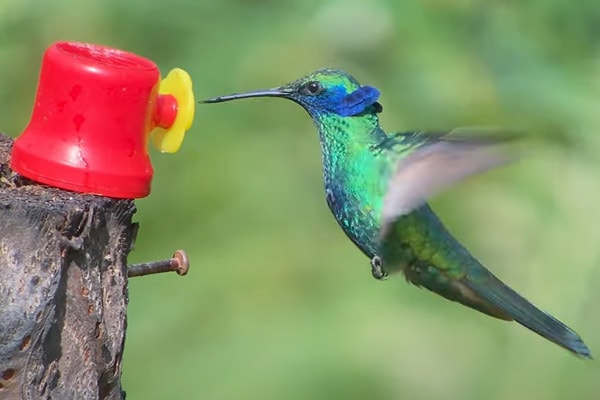
This Hummingbird enjoys a specialized diet primarily focused on nectar that comes from flowering plants. It also gets protein from spiders and other small insects. More specifically:
- Nectar – this Hummingbird will get a significant portion of its diet from flowers that contain nectar. They have long and slender bills that make it easy to extract nectar directly from the center of tubular flowers. They’ll feed on heliconias and bromeliad flowers and they’ll even get their nectar from epiphytes and trees.
- Spiders and Small Insects – this doesn’t make up their primary food source and it doesn’t make up too much of its diet. It’s more like a supplementary food. This Hummingbird can catch bugs while hovering in the air or easily plucks spiders directly off of spiderwebs. More specifically they like to catch spiders, gnats, flies, and other arthropods.
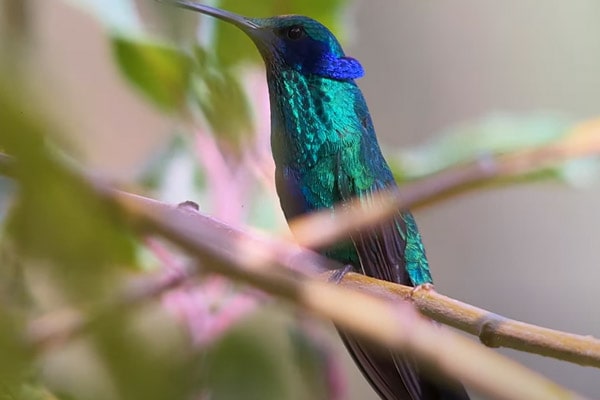
Sparkling violetear Nesting
- Clutch Size: 1-2 eggs
- # of Broods: 1-2 broods
- Incubation Period: 16-18 days
- Nestling period: 20-24 days
- Egg Description: White, Off-White
Sparkling violetear nesting begins when the female takes on the responsibility of constructing the nest. She builds a cup-shaped nest made from soft materials including lichens, moss, plant fibers, and spider silk, which he uses to hold it all together. She creates a sturdy nest that remains camouflaged during nest placement.
The nest is placed in shrubs or trees. Or, depending on the habitat, it might even be made on top of buildings or fences or other man-made structures. No matter what location is chosen, it tends to provide concealment and protection in the form of dense foliage.
After the mother lays a clutch of eggs, she will incubate them for 16-18 days, which gives them enough time to develop and eventually hatch. The male isn’t involved in the incubation process so the female is responsible for this on her own.
After the eggs hatch, caring for the nestlings falls under the purview of male and female Sparkling Violetears. The parents take turns cleaning the nest and feeding their little ones a combination of small insects and regurgitated nectar.
Nestling tends to last for 20-24 days. The young birds will grow rapidly during this time and mature and develop their adult feathers. The young birds even begin exploring outside of their nest as they get bigger and get much closer to fledging.
If conditions are favorable, the Sparkling Violetears will raise more than one brood per breeding season. But they must have abundant food resources available for them to attempt multiple broods.
Sparkling violetear Behavior
As far as behavior is concerned, this Hummingbird exhibits several behaviors that are quite interesting and exciting to see. These notable behaviors and unique characteristics include:
- Aerial Acrobatics – these hummingbirds are quite agile, to say the least, which makes them very adept at flying. In fact, these birds are very well known for their impressive aerial acrobatics. They can fly upside down, fly backward, and even hover. These unique flying abilities make it easy to access nectar and catch bugs in midair.
- Territorial Behavior –sparkling violetears are territorial birds who are known for vigorously defending their nesting in feeding spots. The males are the ones to watch out for because they are very aggressive and will fight when it comes time to defend their territories against intruders. They will engage in aerial chases and establish their dominance to keep their resources safe and protected.
- Courtship Displays – sparkling violetear males are also known for their unique courtship displays during the breeding season. These elaborate displays are specifically designed to attract females. They include engaging in zigzag flights, aerial chases, and vocalizations combined with rapid wing beats. This shows off their fitness and helps them attract a mate.
- Vocalizations – these hummingbirds can produce a number of different vocalizations that they use to communicate with other birds. In their repertoire, they have a number of short songs, trails, buzzes, and chirps. They also use their vocalizations for courtship displays and territorial defense as well as communicating with other hummingbirds.
- Bathing and Sunbathing – in an effort to maintain their plumage, sparkling violetears regularly engage in bathing activities. They use water sources including waterfalls, puddles, and birdbaths when available. They also love to sunbathe while preening their feathers and drying off after a bath. This helps them maintain their beautiful condition and incredible flight performance.
Conservation Status of the Sparkling violetear
The conservation status of the sparkling violetear is recognized as Least Concern By the International Union for Conservation of Nature (IUCN). These birds are quite adaptable and can tolerate habitat alteration to a degree. Their geographic range is relatively large and extends throughout Central and South America, which is also a bonus for these birds.
But that doesn’t mean that their population could and eventually face threats and challenges. Habitat loss because of deforestation is a major potential problem. The same holds true for urbanization and habitat fragmentation. So, conservationists must remain diligent to keep these birds safe and protected.
Fun & Interesting Facts about the Sparkling violetear
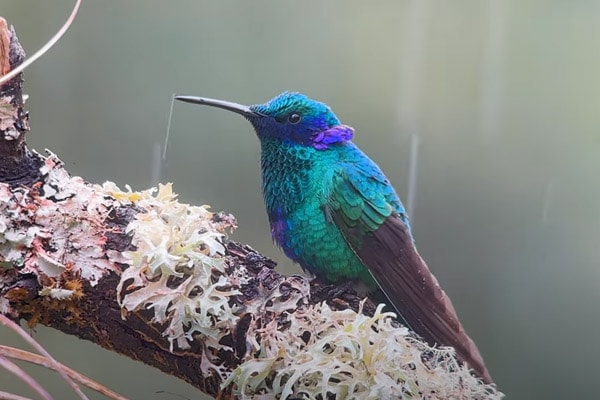
- These birds are very noisy when they hover. The noise is so loud that it produces a distinct buzzing sound due to its rapid wing beats. They will mainly produce this hovering noise while feeding on flowers that have their favorite nectar.
- Male sparkling violetears are incredibly aggressive and territorial. These birds will do everything in their power to ward off intruders. They even engage in high-speed pursuits when necessary.
- Another interesting fact about these hummingbirds is that heir flight patterns are very unique. Their flight capabilities are quite impressive but it’s amazing to watch them fly upside down, backward, and perform intricate maneuvers in the air while foraging.
- Sparkling violetears are a favorite Hummingbird amongst birdwatchers. They will travel far and wide visiting Central and South America to see these beautiful birds and their vibrant colors, unique behaviors, and impressive flight displays.
- They aren’t averse to cooperative nesting. This means the female will construct a nest, and incubate the egg, but both parents will act as caregivers to take care of their nestlings. They take turns maintaining their cleanliness and feeding the young birds.
Explore More Species in This Family
- Cinnamon Hummingbird (Amazilia rutila)
- Long-billed Hermit (Phaethornis longirostris)
- Berylline Hummingbird (Amazilia beryllina)
- Fiery-throated Hummingbird (Panterpe insignis)
- Booted Racket-tail (Ocreatus underwoodii)
- White-necked Jacobin (Florisuga mellivora)
- Red-billed Streamertail (Trochilus polytmus)
- Violet Sabrewing (Campylopterus hemileucurus)
- Blue-throated Hummingbird (Lampornis clemenciae)
- Ruby-throated Hummingbird (Archilochus colubris)
- Long-tailed Sylph (Aglaiocercus kingii)
- Magnificent Hummingbird (Eugenes fulgens)
- Plain-capped Starthroat (Heliomaster constantii)
- Black-throated Mango (Anthracothorax nigricollis)
- Broad-tailed Hummingbird (Selasphorus platycercus)
- White-tailed Goldenthroat (Polytmus guainumbi)
- Violet-headed Hummingbird (Klais guimeti)
- Anna’s Hummingbird (Calypte anna)
- Purple-crowned Fairy (Heliothryx barroti)
- Ecuadorian Hillstar (Oreotrochilus chimborazo)
- Amethyst Woodstar (Calliphlox amethystina)
- Black-crested Coquette (Lophornis helenae)
- Calliope Hummingbird (Selasphorus calliope)
- Long-tailed Hummingbird (Rhamphomicron longicauda)
- White-bellied Woodstar (Chaetocercus mulsant)
- Little Woodstar (Chaetocercus bombus)
- Green-breasted Mango (Anthracothorax prevostii)
- Buff-bellied Hummingbird (Amazilia yucatanensis)
- Gorgeted Woodstar (Chaetocercus heliodor)
- Black-breasted Puffleg (Eriocnemis nigrivestis)
- Costa’s Hummingbird (Calypte costae)
- Green Thorntail (Discosura conversii)
- White-vented Plumeleteer (Chalybura buffonii)
- Crowned Woodnymph (Thalurania colombica)
- Violet-crowned Hummingbird (Amazilia violiceps)
- Black-chinned Hummingbird (Archilochus alexandri)
- Snowcap (Microchera albocoronata)
- Rufous Hummingbird (Selasphorus rufus)
- Xantus’s Hummingbird (Hylocharis xantusii)
- Allen’s Hummingbird (Selasphorus sasin)
- Bronze-tailed Plumeleteer (Chalybura urochrysia)
- Shining Sunbeam (Aglaeactis cupripennis)
- Ruby-topaz Hummingbird (Chrysolampis mosquitus)
- Brazilian Ruby (Clytolaema rubricauda)

